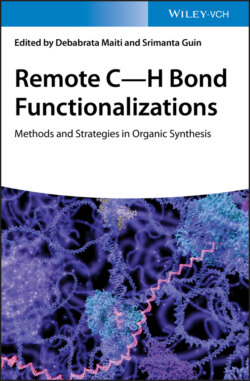Читать книгу Remote C-H Bond Functionalizations - Группа авторов - Страница 19
2.2.3.4 N‐Heterocyclic Arene Derivatives
ОглавлениеDue to the prevalence of N‐heterocycles in biologically important molecules, selective activation of a CH bond of N‐heterocyclic arenes is a conceptually intriguing and synthetically important challenge. For example, to selective activation of CH bonds at C7 of bicyclic tetrahydroquinolines, a novel template will be required since a highly strained intermediate with a tricyclic cyclophane structure will be encountered. In 2014, Yu and coworkers found the template conformation was a critical factor in controlling remote meta‐ or ortho‐selectivity, and when a fluorine substituent was introduced into the auxiliary, the conformation that favored the meta‐selectivity would be dominant in the presence of the MPAA ligand Ac‐Gly‐OH (Scheme 2.28a) [31]. Intriguingly, when the substituents in the auxiliary scaffold were switched to methyl groups, high ortho‐C–H activation at C7 of bicyclic tetrahydroquinolines was observed. With this new directing template by taking advantage of conformation control, remote meta‐C–H olefination of tetrahydroquinolines was achieved in good yield and with high levels of site selectivity (Scheme 2.28b).
Scheme 2.28 (a) Conformation promoted meta‐selective activation. (b) meta‐C–H olefination of tetrahydroquinoline derivatives.
Source: (a) Modified from Tang et al. [31].
Subsequently, Movassaghi, Yu, and coworkers developed a novel nitrile‐based sulfonamide directing template for indolines, since previous directing template for tetrahydroquinolines was not viable presumably due to that the aryl group of indolines is more electron rich and the new skeleton requires a different template to accommodate (Scheme 2.29a) [35]. The new electronically withdrawing sulfonamide linkage is crucial for the meta‐selective C–H functionalization of electron‐rich indolines that are otherwise highly reactive toward electrophilic palladation at the electron‐rich C5‐positions. With this new template and the established reaction conditions, a range of synthetically useful and advanced indoline analogues were efficiently olefinated at the C6 position, meta to the nitrogen atom. Moreover, the sulfonamide template could be removed at room temperature with magnesium turnings in methanol to afford meta‐alkylated indoline derivatives through simultaneous reduction of the newly installed olefins (Scheme 2.29b).
Scheme 2.29 (a) meta‐C–H olefination of indoline derivatives. (b) Removal of directing template.
Source: (a) Modified from Yang et al. [35].
Based on the success of meta‐C–H olefination of electron‐rich indolines, the meta‐C–H arylation of indolines under previously reported meta‐C–H cross‐coupling reaction conditions for hydrocinnamic acid derivatives was also achieved, demonstrating the versatility of this new template for diverse meta‐C–H functionalizations of indolines (Scheme 2.30) [35]. Several indoline substrates reacted with arylboronic acid pinacol esters to afford meta‐arylated indoline derivatives in synthetically useful yields.
Scheme 2.30 meta‐C–H arylation of indoline derivatives.
Source: Modified from Yang et al. [35].
Since the meta‐hydroxylated indolines are biologically important, meta‐C–H acetoxylation of indolines using the well‐established oxidation conditions was also investigated (Scheme 2.31) [35]. It was found that although the meta‐acetoxylated indolines were obtained as the major products, the meta‐selectivity was much lower than olefination and para‐acetoxylated indolines (∼10%) were also formed probably due to the electrophilic palladation at the electron‐rich C5 position under the reaction conditions. It should be mentioned that the nonsubstituted indoline substrate was not compatible with these oxidation conditions, since the indoline was readily oxidized to give a mixture of unidentified compounds instead. Further investigation of this reaction to find better reaction conditions is required.
Scheme 2.31 meta‐C–H acetoxylation of indoline derivatives.
Source: Modified from Yang et al. [35].
In 2018, Yu and coworkers developed a novel simple ortho‐sulfonyl benzonitrile template to achieve remote ortho or meta‐C–H olefination of six different classes of N‐heterocycles, including indoline, indole, and tetrahydroquinoline (Scheme 2.32) [37]. It was demonstrated that the site‐selectivity could be predicted based on distance and geometry, and template‐directed meta‐C–H activation was possible through macrocyclopalladation processes with smaller ring size (10‐membered organometallic ring for indoline and indole).
Scheme 2.32 meta‐C–H olefination of N‐heterocycles.
Source: Modified from Dutta et al. [36].
Stoichiometric installation of the template is not step‐economic, or it would not be attached to the substrate while there is no appropriate functional group to form the covalent linkage. Thus, the design of a catalytic template that binds the substrate via a reversible coordination instead of a covalent linkage is very desirable. In 2017, Yu and coworkers reported a remarkable breakthrough for meta‐C–H olefination of 3‐phenylpyridines by using a catalytic pyridine‐based bifunctional template (Scheme 2.33) [12]. In this reaction, the novel template coordinated two metal centers, one of which one reversibly anchored substrates near the catalyst. The other metal cleaved the meta‐C–H selectively. Notably, unlike previous reaction conditions, the addition of the new copper acetate additive was crucial, since both the yield and the meta‐selectivity would decrease greatly in the absence of copper acetate.
Scheme 2.33 meta‐C–H olefination of 3‐phenylpyridines.
Source: Modified from Zhang et al. [12].
Subsequently, Maiti and coworkers reported a novel nitrile‐based bifunctional template for meta‐C–H olefination of 3‐phenylpyridines with Pd(acac)2 as the catalyst under similar reaction conditions (Scheme 2.34) [13]. Notably, this nitrile‐based bis‐amide template was easily prepared, which was beneficial for its application in the synthesis of complex molecular structures.
Scheme 2.34 meta‐C–H olefination of 3‐phenylpyridines using nitrile‐based bifunctional template.
Source: Modified from Achar et al. [13].
